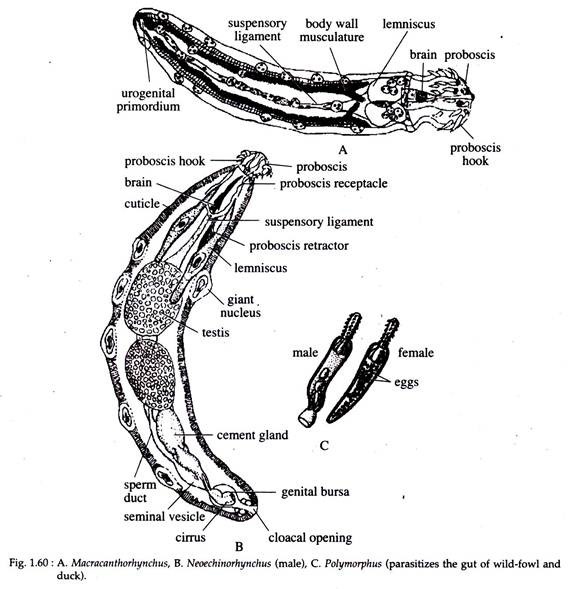In this article we will discuss about Phylum Acanthocephala:- 1. Introduction to Phylum Acanthocephala 2. Diagnostic Features of Phylum Acanthocephala 3. Scheme of Classification 4. Systematic Resume.
Introduction to Phylum Acanthocephala:
The acanthocephalans or thorny headed worms, occur as endoparasites requiring two hosts to complete the life cycle. While the adults live in the digestive tract of aquatic and terrestrial vertebrates, especially fishes, the juveniles on the other hand, are parasitic within crustaceans and insects. Most acanthocephalans are white, but some may vary between red and brown in colour.
Etymology:
Greek: akantha, prickle; kephale, head.
Diagnostic Features of Phylum Acanthocephala:
ADVERTISEMENTS:
i. Body vermiform and bilaterally symmetrical, without segmentation.
ii. Body more than two cell layer thick, with tissues and organs.
iii. Epidermis is a thick syncytial epithelium, with a well-developed web of protein filament that support and toughens the integument. Cuticle absent.
iv. Adult body composed of a trunk and a short proboscis covered with recurved spines (hence the name spiny head).
ADVERTISEMENTS:
v. Body cavity is a pseudocoel.
vi. There is no alimentary system and food is absorbed through the complex body wall.
vii. An unique circulatory system, the lacunar canal system, is located within the epidermis.
viii. Respiratory system absent.
ADVERTISEMENTS:
ix. Nephridia occasionally present.
x. Nervous system comprises of a brain and two principal lateral nerves.
xi. They are dioecious animal with internal fertilization and viviparous development.
xii. The infective larva (acanthor) possesses a rostellum with hooks and requires a crustacea or insect as an intermediate host.
Scheme of Classification of Phylum Acanthocephala:
About 1150 species of acanthocephalans have been identified, that have been placed within three classes by Ruppert and Barnes (1994).
Systematic Resume of Phylum Acanthocephala:
Class Archiacanthocephala:
i. Main lacunar canals are dorsal and ventral.
ii. Presence of eight uninucleate cement glands.
ADVERTISEMENTS:
iii. Absence of trunk spines.
iv. Proboscis receptacle with single muscle layer, often with ventral cleft.
v. Protonephridia present only in one family.
vi. Ligament sacs break down in reproductive females.
vii. Adults are parasite on birds and mammals, while the centipedes, millipedes and insects form the intermediate host.
Examples:
Macracanthorhynchus (Fig. 1.60A), Moniliformis, Oligacanthorhynchus.
Class Eoacanthocephala:
i. Main lacunar canals are dorsal and ventral.
ii. Presence of single syncytial cement gland with giant nuclei.
iii. Trunk spines may be present.
iv. Proboscis receptacle closed, with single muscle layer.
v. Absence of protonephridia.
vi. Ligament sacs persist in reproductive females.
vii. Adults parasitize on fishes, some amphibians and reptiles, while the crustaceans form the intermediate host.
Example:
Neoechinorhynchus (Fig. 1.60B).
Class Palaeacanthocephala:
i. Main lacunar canals lateral.
ii. Presence of two to eight multinucleate cement glands.
iii. Trunk spines may be present.
iv. Proboscis receptacle is present as closed sac and usually with two muscle layers.
v. Absence of protonephridia.
vi. Ligament sac breaks down in reproductive females.
vii. This is the largest and most diverse group where the adult parasitizes on all vertebrate classes and crustaceans form the intermediate host.
Examples:
Polymorphus (Fig. 1.60C), Acanthocephalus, Echinorhynchus, Leptorhynchoides.

